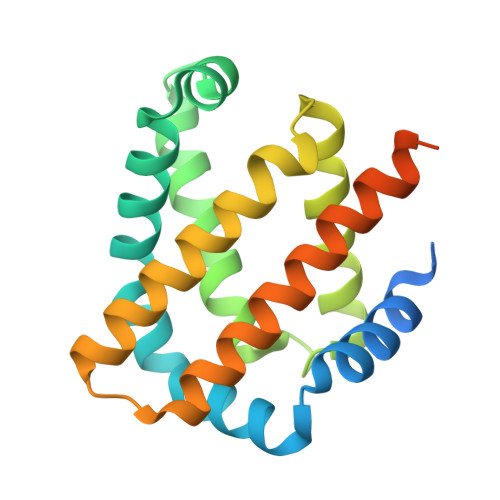A novel single sensor hemoglobin domain from the thermophilic cyanobacteria Thermosynechococcus elongatus BP-1 exhibits higher pH but lower thermal stability compared to globins from mesophilic organisms.
Mathur, S., Yadav, S.K., Yadav, K., Bhatt, S., Kundu, S.(2023) Int J Biol Macromol 240: 124471-124471
- PubMed: 37076076
- DOI: https://doi.org/10.1016/j.ijbiomac.2023.124471
- Primary Citation of Related Structures:
8H17 - PubMed Abstract:
Thermosynechococcus elongatus-BP1 belongs to the class of photoautotrophic cyanobacterial organisms. The presence of chlorophyll a, carotenoids, and phycocyanobilin are the characteristics that categorize T. elongatus as a photosynthetic organism. Here, we report the structural and spectroscopic characteristics of a novel hemoglobin (Hb) Synel Hb from T.elongatus, synonymous with Thermosynechococcus vestitus BP-1. The X-ray crystal structure (2.15 Å) of Synel Hb suggests the presence of a globin domain with a pre-A helix similar to the sensor domain (S) family of Hbs. The rich hydrophobic core accommodates heme in a penta-coordinated state and readily binds an extraneous ligand (imidazole). The absorption and circular dichroic spectral analysis of Synel Hb reiterated that the heme is in Fe III+ state with a predominantly α-helical structure similar to myoglobin. Synel Hb displays higher resistance to structural perturbations induced via external stresses like pH and guanidium hydrochloride, which is comparable to Synechocystis Hb. However, Synel Hb exhibited lower thermal stability compared to mesophilic hemoglobins. Overall, the data is suggestive of the structural sturdiness of Synel Hb, which probably corroborates its origin in extreme thermophilic conditions. The stable globin provides scope for further investigation and may lead to new insights with possibilities for engineering stability in hemoglobin-based oxygen carriers.
Organizational Affiliation:
Department of Biochemistry, University of Delhi South Campus, New Delhi 110021, India; Delhi School of Public Health, Institute of Eminence, University of Delhi, Delhi 110007, India.
















